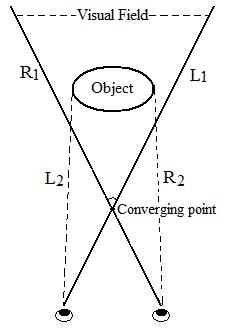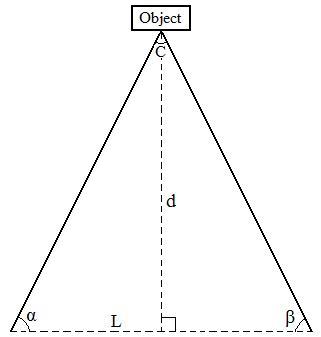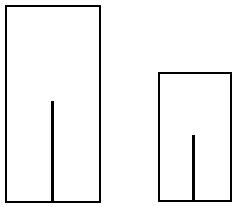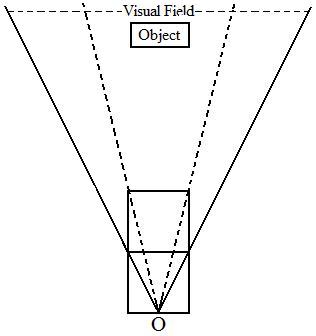

This concept of
converging point is new because it is quite different from the
conventional understanding of the angle of convergence,
which is the angle C in the diagram on the right above. Pr obably
we all agree that we can focus on an object. But I would like to
challenge the conventional understanding of how we focus on objects.
This has serious consequence as to understanding the fore-mentioned rule.
If we formed a convergence angle on the object when we focus
our eyes on it, then we would not be able to see the whole object;
rather we could only see a small part or merely a point of the object.
This result is incredible. In addition, the convergence angle
is used mainly as the distance cue. That is, the convergence angle is
larger when you focus on a nearby object and becomes smaller when you
focus on a farther away object.
The expanding convergence angle plus accommodation of the eyes
will give us cues that the object we focus our eyes on is moving closer
to us.
However, the study by Rock and
Ebenholtz in 1959 shows that as long as the central line's proportion
in the rectangle (see the figure on the right) is kept the same,
we cannot tell whether the rectangle is getting closer or not. My own suggested exercise also shows the same result (see the previous article for details).
That is, holding a photo in your hand and focusing on the photo
only, you do not perceive the objects or people in the photo becoming
larger or smaller while moving it closer or farther away.
As a result of these two experiments, the convergence angle and
accommodation of eyes can be dismissed as cues to distance; more
importantly, the convergence angle may not exist at all. On the other
hand, the converging point
is more likely to be there to help us to focus on objects.
obably
we all agree that we can focus on an object. But I would like to
challenge the conventional understanding of how we focus on objects.
This has serious consequence as to understanding the fore-mentioned rule.
If we formed a convergence angle on the object when we focus
our eyes on it, then we would not be able to see the whole object;
rather we could only see a small part or merely a point of the object.
This result is incredible. In addition, the convergence angle
is used mainly as the distance cue. That is, the convergence angle is
larger when you focus on a nearby object and becomes smaller when you
focus on a farther away object.
The expanding convergence angle plus accommodation of the eyes
will give us cues that the object we focus our eyes on is moving closer
to us.
However, the study by Rock and
Ebenholtz in 1959 shows that as long as the central line's proportion
in the rectangle (see the figure on the right) is kept the same,
we cannot tell whether the rectangle is getting closer or not. My own suggested exercise also shows the same result (see the previous article for details).
That is, holding a photo in your hand and focusing on the photo
only, you do not perceive the objects or people in the photo becoming
larger or smaller while moving it closer or farther away.
As a result of these two experiments, the convergence angle and
accommodation of eyes can be dismissed as cues to distance; more
importantly, the convergence angle may not exist at all. On the other
hand, the converging point
is more likely to be there to help us to focus on objects.

 obably
we all agree that we can focus on an object. But I would like to
challenge the conventional understanding of how we focus on objects.
This has serious consequence as to understanding the fore-mentioned rule.
If we formed a convergence angle on the object when we focus
our eyes on it, then we would not be able to see the whole object;
rather we could only see a small part or merely a point of the object.
This result is incredible. In addition, the convergence angle
is used mainly as the distance cue. That is, the convergence angle is
larger when you focus on a nearby object and becomes smaller when you
focus on a farther away object.
The expanding convergence angle plus accommodation of the eyes
will give us cues that the object we focus our eyes on is moving closer
to us.
However, the study by Rock and
Ebenholtz in 1959 shows that as long as the central line's proportion
in the rectangle (see the figure on the right) is kept the same,
we cannot tell whether the rectangle is getting closer or not. My own suggested exercise also shows the same result (see the previous article for details).
That is, holding a photo in your hand and focusing on the photo
only, you do not perceive the objects or people in the photo becoming
larger or smaller while moving it closer or farther away.
As a result of these two experiments, the convergence angle and
accommodation of eyes can be dismissed as cues to distance; more
importantly, the convergence angle may not exist at all. On the other
hand, the converging point
is more likely to be there to help us to focus on objects.
obably
we all agree that we can focus on an object. But I would like to
challenge the conventional understanding of how we focus on objects.
This has serious consequence as to understanding the fore-mentioned rule.
If we formed a convergence angle on the object when we focus
our eyes on it, then we would not be able to see the whole object;
rather we could only see a small part or merely a point of the object.
This result is incredible. In addition, the convergence angle
is used mainly as the distance cue. That is, the convergence angle is
larger when you focus on a nearby object and becomes smaller when you
focus on a farther away object.
The expanding convergence angle plus accommodation of the eyes
will give us cues that the object we focus our eyes on is moving closer
to us.
However, the study by Rock and
Ebenholtz in 1959 shows that as long as the central line's proportion
in the rectangle (see the figure on the right) is kept the same,
we cannot tell whether the rectangle is getting closer or not. My own suggested exercise also shows the same result (see the previous article for details).
That is, holding a photo in your hand and focusing on the photo
only, you do not perceive the objects or people in the photo becoming
larger or smaller while moving it closer or farther away.
As a result of these two experiments, the convergence angle and
accommodation of eyes can be dismissed as cues to distance; more
importantly, the convergence angle may not exist at all. On the other
hand, the converging point
is more likely to be there to help us to focus on objects. 
